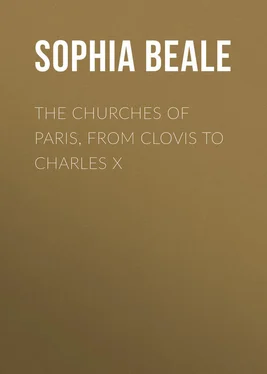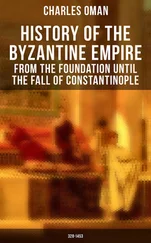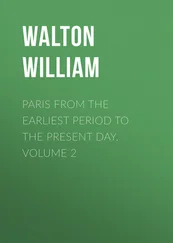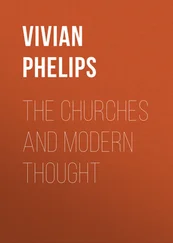Sophia Beale - The Churches of Paris, from Clovis to Charles X
Здесь есть возможность читать онлайн «Sophia Beale - The Churches of Paris, from Clovis to Charles X» — ознакомительный отрывок электронной книги совершенно бесплатно, а после прочтения отрывка купить полную версию. В некоторых случаях можно слушать аудио, скачать через торрент в формате fb2 и присутствует краткое содержание. Жанр: foreign_antique, foreign_prose, на английском языке. Описание произведения, (предисловие) а так же отзывы посетителей доступны на портале библиотеки ЛибКат.
- Название:The Churches of Paris, from Clovis to Charles X
- Автор:
- Жанр:
- Год:неизвестен
- ISBN:нет данных
- Рейтинг книги:3 / 5. Голосов: 1
-
Избранное:Добавить в избранное
- Отзывы:
-
Ваша оценка:
- 60
- 1
- 2
- 3
- 4
- 5
The Churches of Paris, from Clovis to Charles X: краткое содержание, описание и аннотация
Предлагаем к чтению аннотацию, описание, краткое содержание или предисловие (зависит от того, что написал сам автор книги «The Churches of Paris, from Clovis to Charles X»). Если вы не нашли необходимую информацию о книге — напишите в комментариях, мы постараемся отыскать её.
The Churches of Paris, from Clovis to Charles X — читать онлайн ознакомительный отрывок
Ниже представлен текст книги, разбитый по страницам. Система сохранения места последней прочитанной страницы, позволяет с удобством читать онлайн бесплатно книгу «The Churches of Paris, from Clovis to Charles X», без необходимости каждый раз заново искать на чём Вы остановились. Поставьте закладку, и сможете в любой момент перейти на страницу, на которой закончили чтение.
Интервал:
Закладка:
Boileau, in his Lutrin , gives an amusing account of an unseemly squabble which took place between the canons of the chapel, and which was in this wise. On a certain Sunday in 1667, one of the precentors named Barrin found a huge lectern placed in front of his stall. He protested against the intruder, and the other canons taking his part, it was ordered to be removed. But here the treasurer stepped in with objections, and a whole month was passed in discussions, orders, and counter-orders; the dispute only being ended through the mediation of the first president, Guillaume de Lamoignon, who decreed that the precentor should remain imprisoned behind the lectern an entire morning, until the end of the High Mass, the treasurer undertaking to remove the offending piece of furniture before the hour of vespers.
It was the president who suggested this subject to the poet. Boileau had remarked to M. de Lamoignon that an epic poem could be written upon the most trivial incident, if only a poet had sufficient imagination to work it out. " Faites donc un poème sur le débat de la Sainte-Chapelle. Vous pourrez l'intituler 'Le Lutrin enlevé,' ou 'La Conquête du Lutrin. "
" Pourquoi non ," replied Boileau. " Il ne faut jamais défier un fou; et je le suis assez, non seulement pour entreprendre ce poème, mais encore pour le dédier à Monsieur le premier president. "
The result of defying the "fool," who was withal a wit, is a series of portraits in verse, of the canons, the singers, the precentor, and the treasurer. The latter was not spared, as may be seen by the following lines: —
"Dans le réduit obscur d'une alcove enfoncée,
S'élève un lit de plume à grands frais amassée.
Quatre rideaux pompeux, par un double contour,
En défendent l'entrée à la clarté du jour.
Là, parmi les douceurs d'un tranquille silence,
Règne sur le duvet une heureuse indolence.
C'est là que le prélat, muni d'un déjeuner,
Dormant d'un léger sommeil, attendait le dîner.
La jeunesse en sa fleur brille sur son visage;
Son menton sur son sein descend à double étage,
Et son corps, ramassé dans sa courte grosseur,
Fait gémir les coussins sous sa molle épaisseur."
The canons are touched off with an equal vivacity; all their failings and follies, their idleness and their gluttony, brought into the pure light of day:
"Parmi les doux plaisirs d'une paix fraternelle,
Paris voyait fleurir son antique chapelle;
Ses chanoines vermeils et brillants de santé
S'engraissaient d'une longue et sainte oisiveté;
Sans sortir de leurs lits, plus doux que leurs hermines,
Ces pieux fainéants faisaient chanter matines,
Veillaient à bien diner, et laissaient en leur lieu
A des chantres gagés le soin de leur Dieu."
And then the "machine" itself, the offending lutrin , is described:
"Aussitôt dans le chœur la machine emportée,
Est sur le banc du chantre à grand bruit remontée,
Ses ais demi-pourris, que l'âge a relâchés,
Sont à coups de maillet unis et rapprochés;
Sous les coups redoublés tous les bancs retentissent
Les murs en sont émus, les voûtes en mugissent,
Et l'orgue même en pousse un long gemissement."
The dream of the Chantre , perhaps the indirect cause of all the trouble, in making the man cantankerous, and extra liable to be rubbed up the wrong way, is no less worth quoting:
"Les cloches dans les airs, de leurs voix argentines,
Appelaient à grand bruit les chantres à matines,
Quand leur chef, agité d'un sommeil effrayant,
Encor tout en sueur, se réveille en criant:
'Pour la seconde fois (dit-il) un sommeil gracieux
Avait sous ses pavots appesenti mes yeux;
Quand, l'esprit agité d'une douce fumée,
J'ai cru remplir au chœur ma place accoutumée.
Là, triomphant aux yeux des chantres impuissants,
Je bénissais le peuple, et j'avalais l'encens:
Lorsque, du fond caché de notre sacristie,
Une épaisse nuée à grands flots est sortie,
Que s'ouvrant à mes yeux, dans son bleuâtre éclat
M'a fait voir un serpent conduit par le prélat.
Du corps de ce dragon plein de soufre et de nitre,
Une tête sortait en forme de pupitre,
Dont le triangle affreux, tout hérissé de crins,
Surpassait en grosseur nos plus épais lutrins:
Animé par son guide, en sifflant il s'élance.
J'ai crié, mais en vain; et, fuyant sa fureur
Je me suis réveillé plein de trouble et d'horreur."
An order of the Conseil d'Etat, dated March 11, 1787, sequestered all the goods of the chapel, suppressed the chaplaincies and canonries, and ordained that the services should be continued by the king's ordinary chaplains. Three years later, the chapel shared the fate of all the abbeys, chapters, and religious foundations; and soon after, S. Louis' beautiful oratory was closed. The relics were sent to S. Denis, and the other objects were dispersed to the National museums. Propriété Nationale à Vendre was written upon the building, a piece of information which has only disappeared in our own time. Under the Directoire a club held its meetings there; and later, it was converted into a warehouse for corn and flour. Towards 1800, certain ecclesiastics hired the lower chapel and celebrated mass there, but in 1803 it was further profaned; the upper chapel was turned into a depository for judicial documents, and the lower one was given for the same purpose to the Cour des Comptes. In vain Louis XVIII. and Charles X. endeavoured to restore the building to its proper use; and it was only in 1837, in the reign of Louis Philippe, that its restoration was decided upon. MM. Duban, Lassus, Viollet-le-Duc, and Boeswillwald were commissioned to undertake the work at a cost of 2,000,000 francs, a sum nearly equal to the original value of the relics and reliquaries (2,800,000 francs), while it exceeded by nearly two millions the original cost of the building, 800,000 francs. The 3rd November, 1849, the work was sufficiently advanced for the ceremony of the Institution of the Judicature, when the ancient chants were sung as in former times. Since then, until quite recently, a mass has always been celebrated in the chapel, upon the opening of the Law Courts, in the presence of the judges, barristers, and others who could gain admission. But this function has lately been abolished, and the keeper now impresses upon visitors (rather eagerly and unnecessarily), the permission to keep on their hats. " Mais couvrez vous, messieurs, ce n'est plus une chapelle, ce n'est qu'un monument "!
The celebration of the Fête des Fous was one of the customs of the Middle Ages which was very tenacious of life. Although forbidden by the legate in 1198, it flourished for another 250 years. The Council of Paris, held in 1212, endeavoured to put it down; but it was only in 1435 that the Council of Basle succeeded in suppressing it, together with stage plays and other profanities. It was the custom at the Sainte-Chapelle, upon the Holy Innocents' day, for the boy acolytes 4 4 The enfants de chœur of the S. Chapelle seem to have been employed in singing elsewhere for the divertissement of the King: "Les Enfans de Chœur de la Sainte-Chapelle illec disoient de beaux virelets, Chansons et autres Bergerettes, moult mélodieusement."
to deck themselves in the canons' copes and vestments, and to sit in their stalls, one boy bearing the mace carried by the precentor as an attribute of his dignity. They were also exempted, during a certain time, from doing homage to anyone. A curious custom prevailed at Easter. At three o'clock in the morning, the clergy, carrying the Host, went in procession round the interior of the palace; and by reason of a foundation of one of the canons, Eustache Picot, under-master of music during the reigns of Louis XIII. and XIV., only his own compositions could be sung on the occasion. On Easter day a chronological table of the principal events and festivals connected with the chapel, with the date and the age of the King, was attached to the Paschal candle. Other customs were peculiar to the chapel, as, for instance, on Whit Sunday, when, during mass, while the Gospel was chanted, an Angel descended from the vault, holding a silver cruet, from which he poured water upon the hands of the celebrant. Flowers, roses, wafers, a white pigeon, a quantity of small birds, and flax for burning, had to be provided by the Chevecier 5 5 The Chevecier , or Chefcier , was the official who had charge of the altar, the linen, the vases, the ornaments, &c., and who took care of the sacristy and its contents. The treasurer usually held the two offices.
in memory of the tongues of fire which descended upon the apostles at Pentecost.
Интервал:
Закладка:
Похожие книги на «The Churches of Paris, from Clovis to Charles X»
Представляем Вашему вниманию похожие книги на «The Churches of Paris, from Clovis to Charles X» списком для выбора. Мы отобрали схожую по названию и смыслу литературу в надежде предоставить читателям больше вариантов отыскать новые, интересные, ещё непрочитанные произведения.
Обсуждение, отзывы о книге «The Churches of Paris, from Clovis to Charles X» и просто собственные мнения читателей. Оставьте ваши комментарии, напишите, что Вы думаете о произведении, его смысле или главных героях. Укажите что конкретно понравилось, а что нет, и почему Вы так считаете.




![Theresa Cheung - The Dream Dictionary from A to Z [Revised edition] - The Ultimate A–Z to Interpret the Secrets of Your Dreams](/books/692092/theresa-cheung-the-dream-dictionary-from-a-to-z-r-thumb.webp)







